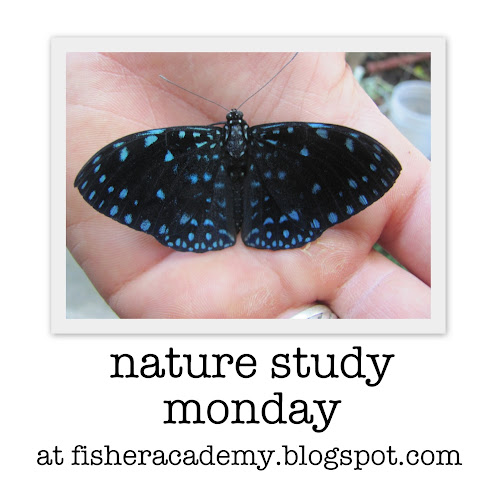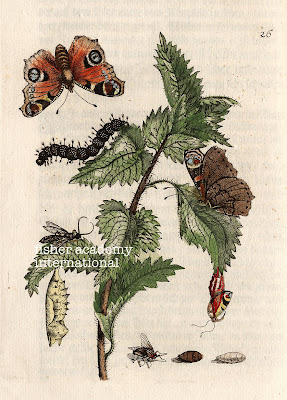“...the child's mind is no mere sac to hold ideas but is rather, if the figure may be allowed, a 'spiritual organism' with an appetite for all knowledge. ”
p111, CM's principle #9 AND the theme of this chapter.
The psychology [think mind is an empty sac/blank slate theory] touted by Herbart [the guy whose philosophy Charlotte primarily refers to in this chapter], is extraordinarily gratifying and attractive to teachers who are, like other people, eager to magnify their office...” because teachers are tempted to show off “how every child is a new creation as he comes forth” out of his or her hands, and may begin to pin the student's success as a result of the teacher's own prowess in teaching.
This may describe many a classroom...even a homeschool? The unit-study approach is particularly in danger of falling into this category. Note the similarities:
- First we have nine lessons in literature and language, the subjects being such as 'Robinson climbs a hill and finds he is on an island.'
- Then, ten object lessons of which the first is,––The Sea, the second, A Ship from Foreign Parts, the sixth, A Life-Boat, the seventh, Shell-Fish, the tenth, A Cave. How these 'objects' are to be produced one does not see.
- The third series are drawing lessons, probably as many, a boat, a ship, an oar, an anchor and so on.
- Then follows a series on manual training, still built upon 'Robinson'; the first, a model of the seashore; then models of Robinson's island, of Robinson's house, and Robinson's pottery.
- The next course consists of reading, an infinite number of lessons,––'passages from The Child's Robinson Crusoe and from a general reader on the matters discussed in object lessons.'
- Then follows a series of writing lessons, "simple compositions on the subject of the lessons. ... the children framed the sentences which the teacher wrote on the blackboard and the class copied afterwards..."
- Arithmetic follows with, no doubt, as many lessons, many mental examples and simple problems dealt with Robinson"; the eighth and last course was in singing and recitation,––'I am monarch of all I survey,' etc. "The lessons lasted about forty-five minutes each.
I'm not trying to single out the unit study approach, however, this bears thinking about. This is why this is such an important issue...
The children who are capable of and eager for a wide range of knowledge and literary expression are reduced to inanities; a lifelong ennui is set up; every approach to knowledge suggests avenues for boredom, and the children's minds sicken and perish long before their school-days come to an end. p116
As I have said elsewhere, the ideas required for the sustenance of children are to be found mainly in books of literary quality; given these the mind does for itself the sorting, arranging, selecting, rejecting, classifying, which Herbart leaves to the struggle of the promiscuous ideas which manage to cross the threshold. p117
Charlotte then moves on to point out how this erroneous [empty sac/blank slate] philosophy works out in the education of the time. Things we see happening again in our time. She quotes from several authors to support her thinking.
"There is too much learning and too little work. The teacher ready to use the powers that his training and experience have given him works too hard while the boy's share in the struggle is too light. It is possible to make education too easy for children and to rob learning of the mental discipline which often wearies but in the end produces concentration and the capacity to work alone...”
p119 CM quoting Alexander Paterson in Across the Bridges.
Charlotte quotes Paterson as he talks about the fact that in Elementary schools time is WASTED on such like as tiresome unit studies or spending too many years teaching the basic R's of education, instead of providing that feast of knowledge on which a mind must inevitably grow. The teacher acts as the prime figure while the student's minds go to waste because, “...the powers of voluntary thought and reason, of spontaneous enquiry and imagination; have not been stirred...”. p120
She goes on to speak about Continuation Schools which seem to refer to high schools, as reference is made to the fact that at one time it was the norm that, “the seventh standard boy about to leave school and take up his life work.” and again, “the average boy whose school-days are to end at fourteen”.
Remember, we're near the Industrial Age when the outcry was growing against children forming part of the work force and their need for schooling... so the subject of Continuation Classes [Poly-technic, which from the context we can deduce that these are high schools that teach a trade].
The problem with education extends and displays itself in life after school in the following ways:
"...we seem to aim at producing a nation of clerks for it is only to a clerk that this perfection of writing and spelling is a necessary training."As a result of a faulty education, while a boy may boast of perfect execution in the kinds of work that would make a successful clerk (3R's), he may not care to boast additionally of the accompanying short attention span, low comprehension, incapability of working alone, feeble memory – which attributes will show themselves quickly in a general laborer or even a professional who at times is obliged to work at a dull job.
What we should aim for then, is that “boys are not trained to be lawyers, or parsons, or doctors, but to be men. If they have learned to work systematically and think independently they are then fit to be trained for such life and profession as taste or necessity may dictate.”
And we are happy with Paterson, who happily remarks that Universities on the other hand, “do not undertake to prepare barristers, parsons, stockbrokers, bankers, or even soldiers and sailors, with a specialised knowledge proper for each profession. Their implicit contention is, given a well educated man with cultivated imagination, trained judgment, wide interests, and he is prepared to master the intricacies of any profession; while he knows at the same time how to make use of himself, of the powers with which nature and education have endowed him for his own happiness; the delightful employment of his leisure; for the increased happiness of his neighbours and the well-being of the community; that is, such a man is able, not only to earn his living, but to live.” p121
In conclusion, I thought this quote particularly inspiring, as we think about how to educate the little persons in our charge:
"What the poor, as well as the rich, require is not to be taught other people's opinions, but to be induced and enabled to think for themselves. It is not physical science that will do this, even if they could learn it much more thoroughly than they are able to do.'
"The young people of this country are not to be regenerated by economic doctrine or economic history or physical science; they can only be elevated by ideas which act upon the imagination and act upon the character and influence the soul, and it is the function of all good teachers to bring those ideas before them.'
John Stuart Mill, quoted by CM on p127
interesting ideas from the chapter:
knowledge/idea as mind food.
Herbart.
apperception mass.
unit studies.
educating the whole person for life.
helpful links:
A Pot of Green Feathers.
CM Blog Carnival on Principle #9
Robinson Crusoe in Education by T.G. Rooper, a PR article (expands on related information presented in this post)
This article, and this one also, seem to be somewhat favorable to at least parts of Herbart's philosophy.
CM volume 6, ch7
Thoughts on the mind of the child and our resulting obligations, from Sally Clarkson
This has been another 'thinking out loud' post, along the lines of chapter 6 of CM's Homeschooling Series, Volume 6, Towards a Philosophy of Education. Did you know that the Charlotte Mason Blog Carnival is going through this volume systematically? Interested? Check out recent posts and the schedule for future posts here.
























